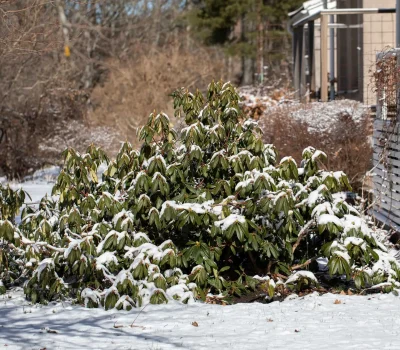Rhododendron vs. mountain laurel vs. azalea — What’s the difference?
It’s easy to mix up azaleas, mountain laurels, and rhododendrons because they share many similarities: all three are flowering shrubs native to North America. While they all belong to the same plant family (Ericaceae), each has distinct characteristics. Let’s explore their similarities and differences to help you identify and choose the right one for your garden.
What do they have in common?
There are three basic similarities between these three plants:
- Same Plant Family: All three belong to the heath family (Ericaceae), which also includes favorites like blueberries and cranberries.
- Beautiful Blooms: These plants all produce colorful flowers that brighten up your yard during their blooming seasons. However, each plant has different blooming seasons. More on that in a few paragraphs…
- Made for Shade: Naturally growing under trees, these shrubs thrive in partial shade and some species can handle deeper shade, too.
Now that we know about their basic similarities, let’s meet all three.
Native Azaleas
Rhododendron genus
There are 18 species of azaleas native to North America. Azaleas cover themselves with five-petaled flowers in the spring. Each of these flowers comes with long “eyelashes” (called stamens) emerging from the center. Native azaleas lose their leaves in the winter (the word for this is deciduous). To make it a little confusing, azaleas are all included within the Rhododendron genus group.
Mountain Laurels
Kalmia genus
All mountain laurel species are native to North America. Mountain laurels have tiny geometric-shaped flowers and are evergreen (keep their leaves year-round.) You’ll know you’ve got a mountain laurel if the Latin name starts with Kalmia.
Native Rhododendrons
Rhododendron genus
There are 850+ rhododendron species worldwide with ten native to North America. Native rhododendrons are known for their dense clumps of large flowers and their large glossy evergreen leaves. Rhododendrons typically bloom in late spring or early summer, depending on the variety.
Now, let’s find the differences between these plants.
What are the differences between azaleas, mountain laurels, and rhododendrons?
The differences between these three plants include:
Mountain laurels and most rhododendrons are evergreen
After mountain laurels and native rhododendrons bloom, their evergreen glossy leaves look great year-round. Because of their evergreen ways, these two plants are perfect shrubs to plant in highly visible areas. If you live in the Northeast, Midwest, or Mid-Atlantic, plant a few of each when you can.

Rhododendrons still have their green leaves in the winter.

Mountain laurels are still green, even in the snow.
On the other hand…
Native azaleas are deciduous
North American native azaleas are deciduous, which means they lose their leaves in the winter. The good news is that many native azaleas’ leaves turn beautiful colors in the fall, giving lots of color even when their blooms are long gone.
Now, let’s talk about the difference in their size.
Mountain laurels tend to be smaller
Mountain laurels are compact, smaller shrubs that grow between 3 to 8 feet. Their branches grow in more open, sculptural forms.
Native rhododendrons and azaleas are typically larger shrubs or even small trees, reaching heights of several feet or more. They often have a more upright growth habit and can form dense clusters of foliage, unless pruned to look differently.
And one more plant to mention…
Now that you know the differences and similarities between azalea, mountain laurel, and rhododendron, we’d like to introduce one more native shrub: Texas Mountain Laurel.
Texas Mountain Laurel
Dermatophyllum secundiflorum
Texas Mountain Laurel is native to Central Texas through to New Mexico. This species has flowers that smell glorious. Read about Texas Mountain Laurel.
We know what you’re thinking—another plant?! But this one is worth meeting.
Texas Mountain Laurels are known for their spectacular purple blooms that smell amazing—most gardeners describe the scent as being like Grape Kool-Aid. If you live in the Southwest—plant a few immediately. Here’s our Texas Mountain Laurel plant profile for more info.
Now that you’ve met these native beauties, let’s talk about what to consider when buying native Mountain Laurel, rhododendrons, and azaleas for your garden.
This first tip is to check the nursery tag twice, to make sure you’re buying native.
When going to the nursery: stick to the native varieties
We mentioned earlier—a few of these plants have huge, world-spanning plant families. Rhododendrons, for instance, have 850+ plants from all over the world in their group. And sadly, most big-box nurseries only carry the non-native types.

FAQs
How can I tell if it's native mountain laurel?
Any mountain laurel you see—whether a true native or a cultivar—comes from plants native to North America.
Feel confident that when you see a Latin plant name that starts with Kalmia, you’ve found a native shrub.
How can I tell if it's a native azalea or rhododendron?
It’s harder to ensure it’s native when it comes to azalea and rhododendrons. It is worth repeating that there are hundreds of species within the rhododendron genus; most of which are native to Asia. When you’re looking for native azaleas or native rhododendrons:
Now you know the basic differences between native azaleas, mountain laurel, and rhododendrons! We hope this gives you the inspiration to plant all three in your semi-shady or shady gardens. Each of these native shrubs is easy to plant, easy to care for, and saves hundreds of hours of work compared to lawn care. Because all of these shrubs are perennials, they will come back year after year. Spend a morning or afternoon planting one of these shrubs and watch them return beauty for decades. Happy planting!
Sources
- Nelson, Gil. Best Native Plants for Southern Gardens: A Handbook for Gardeners, Homeowners, and Professionals, (2010).
- Harstad, Carolyn. Go Native! Gardening with Native Plants and Wildflowers in the Lower Midwest. (1999), 209-210.



















